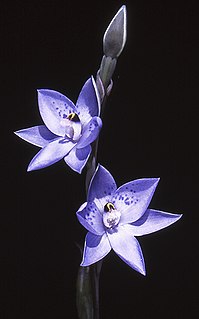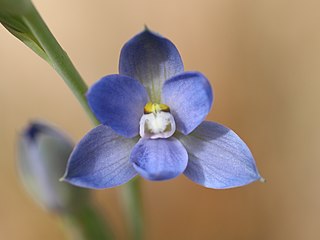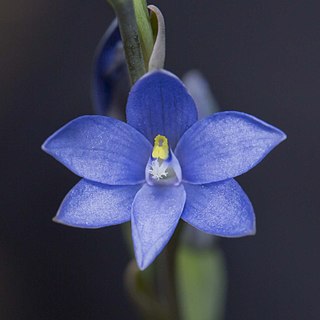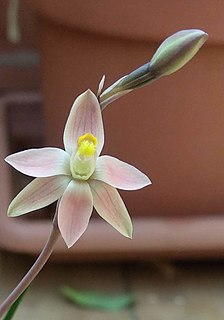
Thelymitra aristata, commonly called the great sun orchid, is a species of orchid that is endemic to south-eastern Australia. It has a single large, thick leaf and bracts and up to forty crowded blue or purplish flowers with darker veins.
Thelymitra aggericola, commonly called the bleak sun orchid, is a species of orchid that is endemic to Tasmania. It has a single long, curved leaf and up to seven or more white to pale blue flowers, green on their back side.
Thelymitra imbricata, commonly called the broad sun orchid, is a species of orchid that is endemic to Tasmania. It has a single erect, channelled leaf and up to fifteen or more pale to dark or purplish blue, relatively large flowers.
Thelymitra albiflora, commonly called the white sun orchid, is a species of orchid that is endemic to South Australia. It has a single erect, narrow, fleshy leaf and up to ten relatively small white flowers with white toothbrush-like tufts on top of the anther.
Thelymitra basaltica, commonly called the grassland sun orchid, is a species of orchid that is endemic to Victoria. It has a single fleshy, channelled, dark green leaf and up to eight small pale blue, self-pollinating flowers which open only slowly on warm to hot days.
Thelymitra exigua, commonly called the short sun orchid, is a species of orchid that is endemic to south-eastern Australia. It has a single fleshy, channelled, dark green leaf and up to eight relatively small pale blue flowers with white toothbrush-like tufts on top of the anther.
Thelymitra cyanapicata, commonly called the dark-tipped sun orchid, is a species of orchid that is endemic to South Australia. It has a single fleshy, linear, channelled leaf and up to three small blue or pale purplish to maroon flowers with a dark purplish blue top of the anther.

Thelymitra granitora, commonly called the coastal granite sun orchid or coastal sun orchid, is a species of orchid in the family Orchidaceae and is endemic to the south-west of Western Australia. It has a single short, curved and channelled dark green leaf and up to eight relatively large pale blue or white, self-pollinating flowers with white mop-like tufts on the top of the anther.

Thelymitra holmesii, commonly called the blue star sun orchid, is a species of orchid that is endemic to south-eastern Australia. It has a single long, narrow, fleshy leaf and up to nine purplish blue to mauve flowers with a deeply notched lobe on top of the anther.
Thelymitra viridis, commonly called the green sun orchid, is a species of orchid that is endemic to Tasmania. It has a single erect, fleshy, channelled leaf and up to seven small self-pollinating pale blue to pale purplish flowers. The rest of the plant is a pale green colour.
Thelymitra inflata, commonly called the inflated sun orchid, is a species of orchid that is endemic to south eastern Australia. It has a single long, erect, linear leaf and up to six dark blue to purplish flowers with a very inflated lobe on top of the anther.
Thelymitra lucida, commonly called the glistening sun orchid, is a species of orchid that is endemic to south eastern Australia. It has a single erect, fleshy leaf and up to seven dark blue flowers with the sepals a lighter blue than the petals.

Thelymitra mucida, commonly called the plum sun orchid or plum orchid, is a species of orchid that is endemic to southern Australia. It has a single erect, fleshy, linear leaf and up to six blue, purplish or plum coloured flowers with a thick, sticky secretion on the anther lobe.

Thelymitra simulata, commonly called the collared sun orchid, is a species of orchid that is endemic to south-eastern Australia. It has a single fleshy, channelled leaf and up to six blue flowers with small darker spots. It grows in higher altitudes places part and the flowers have a purple lobe with a yellow tip on top of the anther.
Thelymitra spadicea, commonly called the browntop sun orchid, is a species of orchid that is endemic to Tasmania. It has a single erect, fleshy leaf and up to four relatively small blue flowers with small darker spots and an elongated lobe on top of the anther.
Thelymitra sparsa, commonly called the wispy sun orchid, is a species of orchid that is endemic to Tasmania. It has a single erect, fleshy leaf and up to six relatively small blue flowers with a few small darker spots. The flowers are self-pollinated and open only slowly on hot days. The species is restricted to a few restricted montane sites in south-eastern Tasmania.

Thelymitra improcera, commonly called the coastal sun orchid, is a species of orchid that is endemic to south-eastern Australia. It has a single erect, fleshy leaf and up to eight relatively small pale to bright blue flowers on a short flowering stem. The lobe on top of the anther is unusually short and lobed.

Thelymitra longiloba, commonly called the lobed sun orchid, is a species of orchid that is endemic to south-eastern Australia. It has a single erect, fleshy, channelled leaf and up to six relatively small blue flowers with side lobes above the anther. Although widespread, it only occurs in disjunct populations and is classed as "endangered".
Thelymitra erosa, commonly called the striped sun orchid, is a species of orchid that is endemic to Tasmania. It has a single erect, fleshy dark green leaf and up to eight moderately large dark blue to purplish or pink flowers with darker veins. The column arms have irregular lobes.

Thelymitra glaucophylla is a species of orchid that is endemic to South Australia. It has a single erect, channelled, pale green leaf and up to fifteen pale blue, mauve or white flowers with an inflated, greyish lobe on top of the anther.







